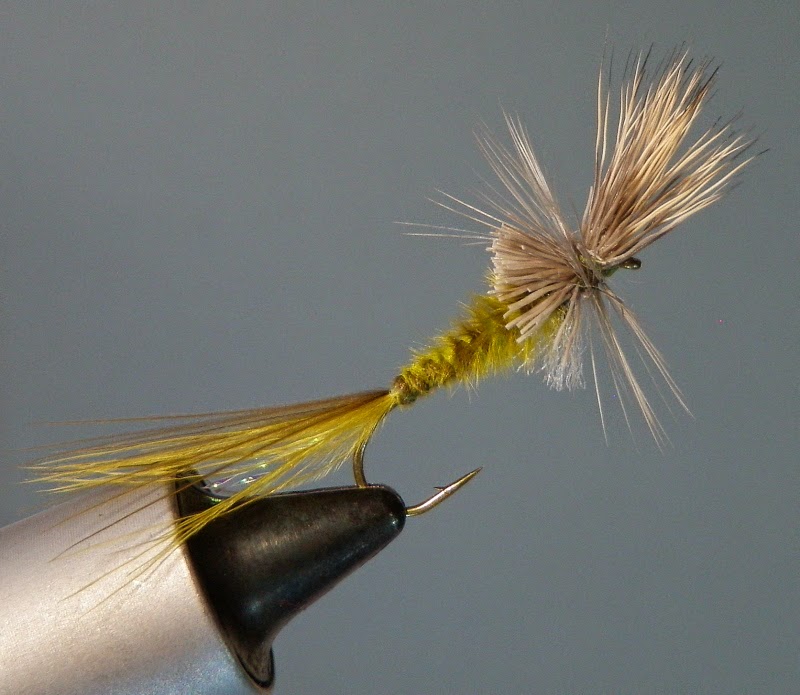 |
| Pale Olive/Grey |
The May Break is definitely a version of the popular Quigley Cripple. The difference is that I have substituted some of the materials used in the original with materials to provide the triggers I have found highly successful in my fishing. The least of these triggers is a blended marabou abdomen.
The first time I ever encountered
the big Green Drakes that inspired this fly was in the Sierras in California. I
stumbled upon a hatch on a small creek and every trout in the creek was up and
feeding with gusto. The closest match I had were some oversized Adams
parachutes. I was able to take a few of the feeding trout but the big brown
trout at the head of the run wouldn’t even give it a look. What I didn’t
realize at the time was the trout were actually feeding on the emergers and not
the duns which were alight as soon as they popped through the meniscus.
 |
| Dark Olive/Grey |
That very evening I tied over a
dozen big Catskill style dry imitations. I've carried them ever since, hooks
starting to rust and wings being crushed.
The second time I confronted a
hatch of these out-sized flies was fishing the North Fork of the Shoshone River
between Yellowstone Park and Cody, Wyoming. I encountered a hatch of the drakes
at a hole I frequented in mid-summer. The hungry cutthroats were staged at the
head of a pool below a short run of rapids. The Drakes were emerging just as
they entered the pool. The fish had formed a feeding conga line.
I pulled out the now rusty dries
that had been with me for nearly 10 years and began casting. The fly drifted
through the feeders time and again with only one refusal rise. Not wanting to
put them down I stopped and observed.
The largest fish were stationed
just behind the smaller more eager feeders which were taking the pre-emergers
below the surface. The largest fish were waiting until the Drakes actually began
to break the surface, the most vulnerable point for the insects. Only the
straggling feeders in the back of the pod were feeding on the adults. On the
clear, warm and dry day they weren’t having much luck because the adults were
in flight almost instantly after emerging.
I took out my scissors and went
to work on my fly. I clipped and trimmed making drifts below the feeding fish
until only the wings protruded above the surface. The first successful drift
came 2 casts in. One of the trout at the back of the run took with an anxious
strike. I worked the pod back to front picking off a dozen fat cutthroats,
including a pair that measured over the 21” mark on my rod, before the hatch
ended.
 |
| Dark Olive/Light Olive |
That evening I tied for hours
configuring and tweaking to get a fly that would imitate the emergers and hang
under the surface just right. The next 3 days I fished the afternoon and tied
at night getting everything just the way I wanted. On the fourth day a known
observer from the day before had the run before I got there. I tried waiting
him out but another interloper showed up before I vacated the parking pull-out
to fish the afternoon hopper bite downstream.
It was a year before I got to
test the final version on Gray Drake hatch on the western side of Yellowstone
Park. The flies worked just the way I wanted and the trout agreed.
FISHING
Fish the May Break as you would
any other emerger pattern in freestone rivers or tailwaters. The design of the
fly makes it very suitable for all water types though it performs best in rough
water. A drag free drift is usually best
but because it is intended to represent an emerging insect an occasional twitch
can induce an undecided fish to take. Although it isn’t necessary, I usually
apply a liberal amount of floatant to the hackle and wings of the fly to keep
it floating high. The fly is designed to ride with the entire abdomen submerged
so it is advisable to dampen the abdomen and tail of the fly to ensure it
sinks. The large deer hair wing makes the fly very visible even in rough water.
 |
| Light Olive/Grey |
Fishing the May Break during or
just after a hatch is very productive. I have also had success with this fly
using it as a searching pattern up to 3 days after the last known hatch.
Available in - Dark Olive/Light Olive, Dark Olive/Gray, Light Olive/Gray, Pale Olive/Gray
Size 10 - 14
Available in - Dark Olive/Light Olive, Dark Olive/Gray, Light Olive/Gray, Pale Olive/Gray
Size 10 - 14
 |
| Dark Olive/Gray |
 |
| Dark Olive/Light Olive |
 |
| Dark Olive/Gray |
 |
| Pale Olive/Gray |



No comments:
Post a Comment